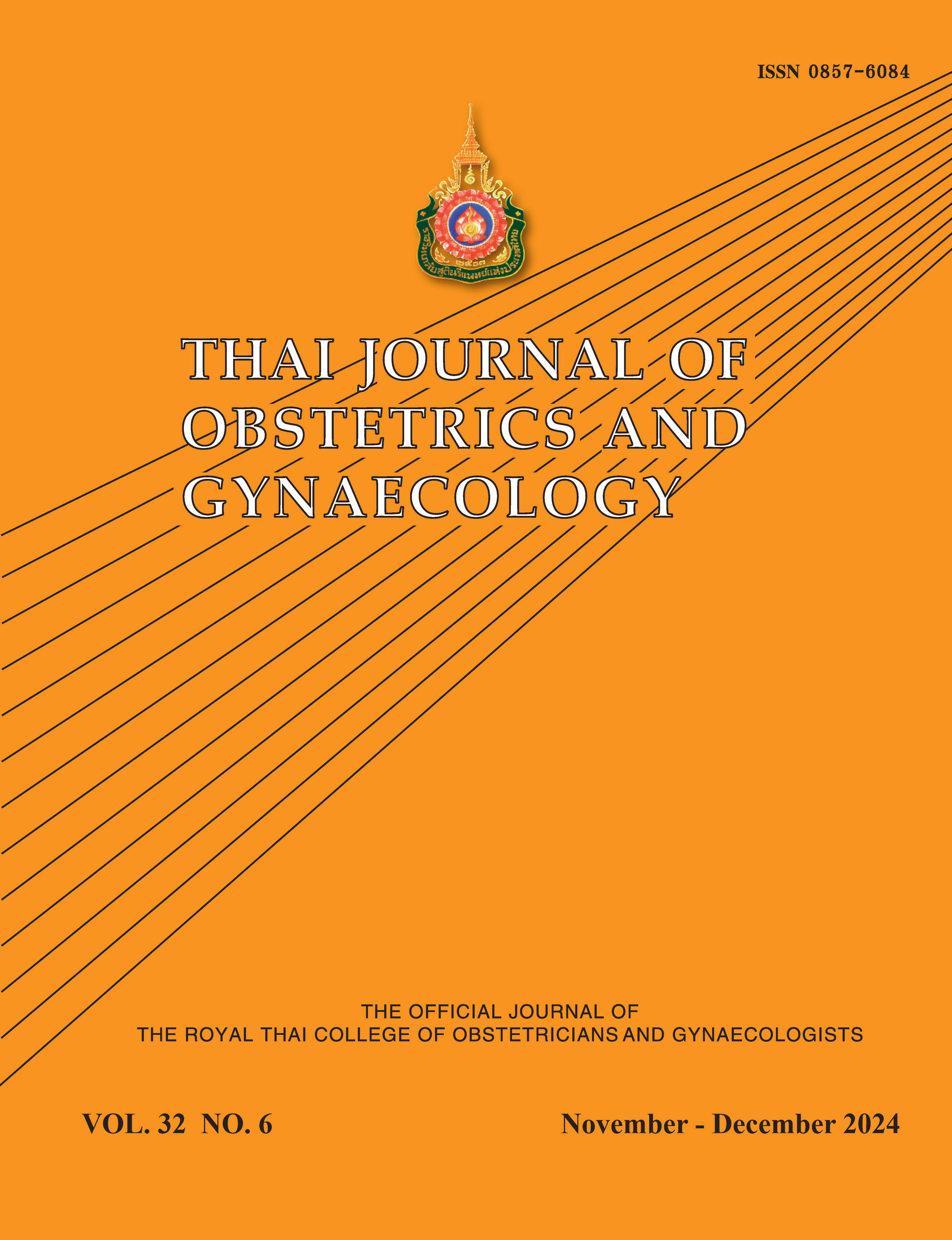Difference between Paired Umbilical Arteries Doppler Velocimetry Indices in Singleton Pregnancy
Main Article Content
Abstract
Objectives: To assess variance between paired umbilical artery Doppler velocity indices in pregnancies at 18-37 weeks.
Materials and Methods: We enrolled 450 women with singleton pregnancies, aged 18-37 weeks, between April 2023 and January 2024. They underwent Doppler transabdominal ultrasound to assess both umbilical arteries in a free-floating loop of umbilical cord. We recorded umbilical artery Doppler pulsatility index (PI), resistance index (RI), and systolic/diastolic (S/D) ratio for each umbilical artery.
Results: 418 women were analyzed. Mean PI, RI, and S/D ratio at each gestational age (18 - 37 weeks) significantly differed between paired umbilical arteries (p < 0.05). Discrepancies > 10% in PI, RI, and S/D ratio between the two umbilical arteries were observed in 48.6%, 23.9%, and 56.7% of cases, respectively. Discrepancy > 20% were observed in 12.7%, 2.6%, and 22% of cases, respectively.
Conclusion: Significant differences existed in PI, RI, and S/D ratio between the two umbilical arteries. As gestational age advances, there was a gradual decrease in the PI, RI, and S/D ratio. The mean difference in the S/D ratio between the two umbilical arteries tended to decrease as gestational age increased. Further considerations are necessary to determine whether the nomogram values, derived from measuring only one umbilical artery, should be based on higher or lower values, or if they should consider a specific relationship between the two umbilical arteries.
Article Details

This work is licensed under a Creative Commons Attribution-NonCommercial-NoDerivatives 4.0 International License.
References
Acharya G, Wilsgaard T, Berntsen GK, Maltau JM, Kiserud T. Reference ranges for serial measurements of blood velocity and pulsatility index at the intra-abdominal portion, and fetal and placental ends of umbilical artery. Ultrasound Obstet Gynecol 2005;26: 162-9.
Alfirevic Z, Stampalija T, Dowswell T. Fetal and umbilical Doppler ultrasound in high-risk pregnancies. Cochrane Database Syst Rev 2017;6:CD007529.
American College of Obstetricians and Gynecologists’ Committee on Practice Bulletins-Obstetrics and the Society for Maternal-Fetal Medicine. ACOG practice bulletin no. 204: fetal growth restriction. Obstet Gynecol 2019;133:e97-109.
Martins JG, Biggio JR, Abuhamad A. Society for Maternal-Fetal Medicine Consult Series #52: diagnosis and management of fetal growth restriction: (replaces Clinical Guideline Number 3, April 2012). Am J Obstet Gynecol 2020;223:B2-B17.
ISUOG Practice Guidelines: use of Doppler velocimetry in obstetrics. Ultrasound Obstet Gynecol 2020;58: 331-9.
Benirschke K, Kaufman P. Anatomy and pathology of the umbilical cord and major fetal vessels. In: Benirschke K, Kaufman P, eds. Pathology of the human placenta. 3rd ed. New York: Springer;1995:319-77.
Predanic M, Perni SC. Antenatal assessment of discordant umbilical arteries in singleton pregnancies. Croat Med J 2006;47:701-8.
Steller JG, Driver C, Gumina D, Peek E, Harper T, Hobbins JC, et al. Doppler velocimetry discordance between paired umbilical artery vessels and clinical implications in fetal growth restriction. Am J Obstet Gynecol 2022;227:285.e1-285.e7.
Dolkart LA, Reimers FT, Kuonen CA. Discordant umbilical arteries: ultrasonographic and Doppler analysis. Obstet Gynecol 1992;79:59-63.
Petrikovski B, Schneider E. Prenatal diagnosis and clinical significance of hypoplastic umbilical artery. Prenat Diagn 1996;16:938-940.
Raio L, Ghezzi F, Di Naro E, Gomez R, Saile G, Brunhwiler H. The clinical significance of antenatal detection of discordant umbilical arteries. Obstet Gynecol 1998;91:86-91.
Ayoola OO, Bulus P, Loto OM, Idowu BM. Normogram of umbilical artery Doppler indices in singleton pregnancies in south-western Nigerian women. J ObstetGynaecol Res 2016;42:1694-8.
Sutantawiboon A, Chawapaiboon S. Doppler study of umbilical artery in Thai fetus. J Med Assoc Thai 2011;94: 1283-7.
Byun YJ, Kim HS, Yang JI, Kim JH, Kim HY, Chang SJ. Umbilical artery doppler study as a predictive marker of perinatal outcome in preterm small for gestational age infants. Yonsei Med J 2009;50:39-44.
Acharya G, Wilsgaard T, Berntsen GKR, Maltau JM, Kiserud T. Reference ranges for serial measurements of umbilical artery Doppler indices in the second half of pregnancy. Am J Obstet Gynecol 2005;192:937-44.
Predanic M, Kolli J, Yousefzadeh P, Pennisi J. Disparate blood flow pattern in parallel umbilical arteries. Obstet Gynecol 1998;91:757-60.
Raio L, Ghezzi F, Di Naro E, Franchi M, Brühwiler H. Prenatal assessment of the Hyrtl anastomosis and evaluation of its function: case report. Hum Reprod 1999;14:1890-3.
Raio L, Ghezzi F, Di Naro E, Franchi M, Balestreri D, Dürig P, et al. In-utero characterization of the blood flow in Hyrtl anastomosis. Placenta 2001;22:597-601.
Ulberg U, Lingman G, Ekman-Orderberg G, Sandstedt B. Hyrtl’s anastomosis is normally developed in placentas from small for gestational age infants. Acta Obstet Gynecol Scand 2003;82:716-21.
Gordon Z, Eytan O, Jaffa AJ, Elad D. Hemodynamic analysis of Hyrtl anastomosis in human placenta. Am J Physiol Regul Integr Comp Physiol 2007;292:R977-R982.
Gur EB, Gulec ES, Aydogmus S, Gur MS, Yazici Tekeli E, et al. Can the difference of Doppler indexes at different points of the umbilical cord predict to the umbilical cord length? J Matern Fetal Neonatal Med 2020;33:847-51.
Cahill LS, Mercer GV, Jagota D, Chandran AR, Milligan N, Shinar S, et al. Doppler ultrasound of the fetal descending aorta: an objective tool to assess placental blood flow resistance in pregnancies with discordant umbilical arteries. J Ultrasound Med 2022;41:899-905.


